Christina Chaccour
Large-Scale AI in Telecom: Charting the Roadmap for Innovation, Scalability, and Enhanced Digital Experiences
Mar 06, 2025Abstract:This white paper discusses the role of large-scale AI in the telecommunications industry, with a specific focus on the potential of generative AI to revolutionize network functions and user experiences, especially in the context of 6G systems. It highlights the development and deployment of Large Telecom Models (LTMs), which are tailored AI models designed to address the complex challenges faced by modern telecom networks. The paper covers a wide range of topics, from the architecture and deployment strategies of LTMs to their applications in network management, resource allocation, and optimization. It also explores the regulatory, ethical, and standardization considerations for LTMs, offering insights into their future integration into telecom infrastructure. The goal is to provide a comprehensive roadmap for the adoption of LTMs to enhance scalability, performance, and user-centric innovation in telecom networks.
Artificial General Intelligence (AGI)-Native Wireless Systems: A Journey Beyond 6G
Apr 29, 2024



Abstract:Building future wireless systems that support services like digital twins (DTs) is challenging to achieve through advances to conventional technologies like meta-surfaces. While artificial intelligence (AI)-native networks promise to overcome some limitations of wireless technologies, developments still rely on AI tools like neural networks. Such tools struggle to cope with the non-trivial challenges of the network environment and the growing demands of emerging use cases. In this paper, we revisit the concept of AI-native wireless systems, equipping them with the common sense necessary to transform them into artificial general intelligence (AGI)-native systems. These systems acquire common sense by exploiting different cognitive abilities such as perception, analogy, and reasoning, that enable them to generalize and deal with unforeseen scenarios. Towards developing the components of such a system, we start by showing how the perception module can be built through abstracting real-world elements into generalizable representations. These representations are then used to create a world model, founded on principles of causality and hyper-dimensional (HD) computing, that aligns with intuitive physics and enables analogical reasoning, that define common sense. Then, we explain how methods such as integrated information theory play a role in the proposed intent-driven and objective-driven planning methods that maneuver the AGI-native network to take actions. Next, we discuss how an AGI-native network can enable use cases related to human and autonomous agents: a) analogical reasoning for next-generation DTs, b) synchronized and resilient experiences for cognitive avatars, and c) brain-level metaverse experiences like holographic teleportation. Finally, we conclude with a set of recommendations to build AGI-native systems. Ultimately, we envision this paper as a roadmap for the beyond 6G era.
Causal Reasoning: Charting a Revolutionary Course for Next-Generation AI-Native Wireless Networks
Sep 23, 2023



Abstract:Despite the basic premise that next-generation wireless networks (e.g., 6G) will be artificial intelligence (AI)-native, to date, most existing efforts remain either qualitative or incremental extensions to existing ``AI for wireless'' paradigms. Indeed, creating AI-native wireless networks faces significant technical challenges due to the limitations of data-driven, training-intensive AI. These limitations include the black-box nature of the AI models, their curve-fitting nature, which can limit their ability to reason and adapt, their reliance on large amounts of training data, and the energy inefficiency of large neural networks. In response to these limitations, this article presents a comprehensive, forward-looking vision that addresses these shortcomings by introducing a novel framework for building AI-native wireless networks; grounded in the emerging field of causal reasoning. Causal reasoning, founded on causal discovery, causal representation learning, and causal inference, can help build explainable, reasoning-aware, and sustainable wireless networks. Towards fulfilling this vision, we first highlight several wireless networking challenges that can be addressed by causal discovery and representation, including ultra-reliable beamforming for terahertz (THz) systems, near-accurate physical twin modeling for digital twins, training data augmentation, and semantic communication. We showcase how incorporating causal discovery can assist in achieving dynamic adaptability, resilience, and cognition in addressing these challenges. Furthermore, we outline potential frameworks that leverage causal inference to achieve the overarching objectives of future-generation networks, including intent management, dynamic adaptability, human-level cognition, reasoning, and the critical element of time sensitivity.
Catch Me If You Can: Deep Meta-RL for Search-and-Rescue using LoRa UAV Networks
Jun 12, 2023



Abstract:Long range (LoRa) wireless networks have been widely proposed as a efficient wireless access networks for the battery-constrained Internet of Things (IoT) devices. In many practical search-and-rescue (SAR) operations, one challenging problem is finding the location of devices carried by a lost person. However, using a LoRa-based IoT network for SAR operations will have a limited coverage caused by high signal attenuation due to the terrestrial blockages especially in highly remote areas. To overcome this challenge, the use of unmanned aerial vehicles (UAVs) as a flying LoRa gateway to transfer messages from ground LoRa nodes to the ground rescue station can be a promising solution. In this paper, the problem of the flying LoRa (FL) gateway control in the search-and-rescue system using the UAV-assisted LoRa network is modeled as a partially observable Markov decision process. Then, a deep meta-RL-based policy is proposed to control the FL gateway trajectory during SAR operation. For initialization of proposed deep meta-RL-based policy, first, a deep RL-based policy is designed to determine the adaptive FL gateway trajectory in a fixed search environment including a fixed radio geometry. Then, as a general solution, a deep meta-RL framework is used for SAR in any new and unknown environments to integrate the prior FL gateway experience with information collected from the other search environments and rapidly adapt the SAR policy model for SAR operation in a new environment. The proposed UAV-assisted LoRa network is then experimentally designed and implemented. Practical evaluation results show that if the deep meta-RL based control policy is applied instead of the deep RL-based one, the number of SAR time slots decreases from 141 to 50.
Joint Sensing, Communication, and AI: A Trifecta for Resilient THz User Experiences
Apr 29, 2023



Abstract:In this paper a novel joint sensing, communication, and artificial intelligence (AI) framework is proposed so as to optimize extended reality (XR) experiences over terahertz (THz) wireless systems. The proposed framework consists of three main components. First, a tensor decomposition framework is proposed to extract unique sensing parameters for XR users and their environment by exploiting then THz channel sparsity. Essentially, THz band's quasi-opticality is exploited and the sensing parameters are extracted from the uplink communication signal, thereby allowing for the use of the same waveform, spectrum, and hardware for both communication and sensing functionalities. Then, the Cramer-Rao lower bound is derived to assess the accuracy of the estimated sensing parameters. Second, a non-autoregressive multi-resolution generative artificial intelligence (AI) framework integrated with an adversarial transformer is proposed to predict missing and future sensing information. The proposed framework offers robust and comprehensive historical sensing information and anticipatory forecasts of future environmental changes, which are generalizable to fluctuations in both known and unforeseen user behaviors and environmental conditions. Third, a multi-agent deep recurrent hysteretic Q-neural network is developed to control the handover policy of reconfigurable intelligent surface (RIS) subarrays, leveraging the informative nature of sensing information to minimize handover cost, maximize the individual quality of personal experiences (QoPEs), and improve the robustness and resilience of THz links. Simulation results show a high generalizability of the proposed unsupervised generative AI framework to fluctuations in user behavior and velocity, leading to a 61 % improvement in instantaneous reliability compared to schemes with known channel state information.
The Seven Worlds and Experiences of the Wireless Metaverse: Challenges and Opportunities
Apr 20, 2023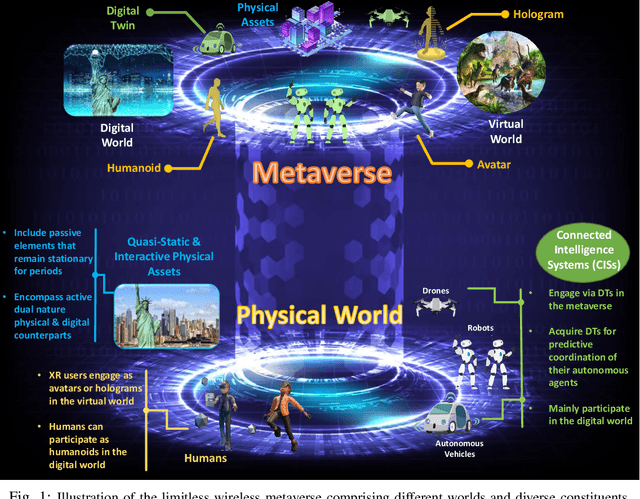
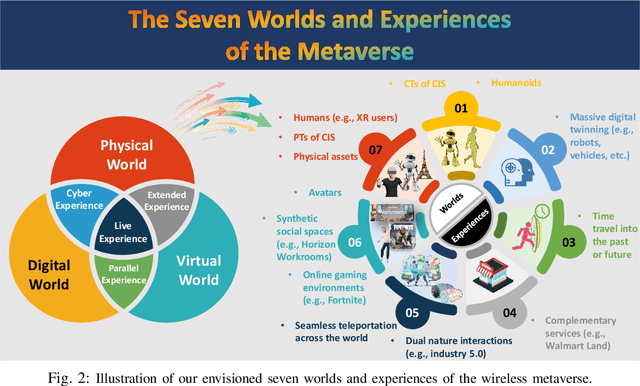
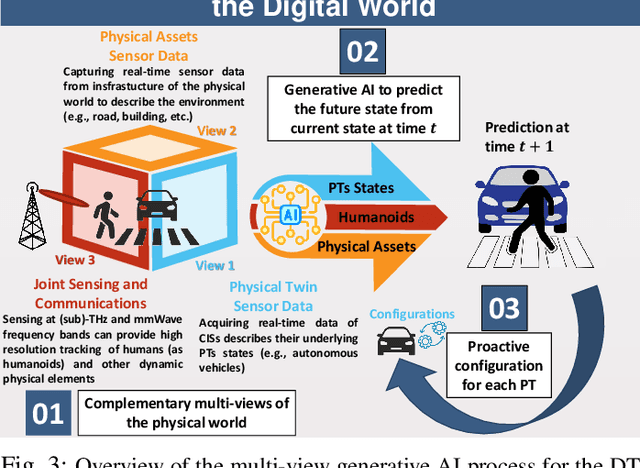
Abstract:The wireless metaverse will create diverse user experiences at the intersection of the physical, digital, and virtual worlds. These experiences will enable novel interactions between the constituents (e.g., extended reality (XR) users and avatars) of the three worlds. However, remarkably, to date, there is no holistic vision that identifies the full set of metaverse worlds, constituents, and experiences, and the implications of their associated interactions on next-generation communication and computing systems. In this paper, we present a holistic vision of a limitless, wireless metaverse that distills the metaverse into an intersection of seven worlds and experiences that include the: i) physical, digital, and virtual worlds, along with the ii) cyber, extended, live, and parallel experiences. We then articulate how these experiences bring forth interactions between diverse metaverse constituents, namely, a) humans and avatars and b) connected intelligence systems and their digital twins (DTs). Then, we explore the wireless, computing, and artificial intelligence (AI) challenges that must be addressed to establish metaverse-ready networks that support these experiences and interactions. We particularly highlight the need for end-to-end synchronization of DTs, and the role of human-level AI and reasoning abilities for cognitive avatars. Moreover, we articulate a sequel of open questions that should ignite the quest for the future metaverse. We conclude with a set of recommendations to deploy the limitless metaverse over future wireless systems.
Disentangling Learnable and Memorizable Data via Contrastive Learning for Semantic Communications
Dec 18, 2022


Abstract:Achieving artificially intelligent-native wireless networks is necessary for the operation of future 6G applications such as the metaverse. Nonetheless, current communication schemes are, at heart, a mere reconstruction process that lacks reasoning. One key solution that enables evolving wireless communication to a human-like conversation is semantic communications. In this paper, a novel machine reasoning framework is proposed to pre-process and disentangle source data so as to make it semantic-ready. In particular, a novel contrastive learning framework is proposed, whereby instance and cluster discrimination are performed on the data. These two tasks enable increasing the cohesiveness between data points mapping to semantically similar content elements and disentangling data points of semantically different content elements. Subsequently, the semantic deep clusters formed are ranked according to their level of confidence. Deep semantic clusters of highest confidence are considered learnable, semantic-rich data, i.e., data that can be used to build a language in a semantic communications system. The least confident ones are considered, random, semantic-poor, and memorizable data that must be transmitted classically. Our simulation results showcase the superiority of our contrastive learning approach in terms of semantic impact and minimalism. In fact, the length of the semantic representation achieved is minimized by 57.22% compared to vanilla semantic communication systems, thus achieving minimalist semantic representations.
Less Data, More Knowledge: Building Next Generation Semantic Communication Networks
Nov 25, 2022



Abstract:Semantic communication is viewed as a revolutionary paradigm that can potentially transform how we design and operate wireless communication systems. However, despite a recent surge of research activities in this area, the research landscape remains limited. In this tutorial, we present the first rigorous vision of a scalable end-to-end semantic communication network that is founded on novel concepts from artificial intelligence (AI), causal reasoning, and communication theory. We first discuss how the design of semantic communication networks requires a move from data-driven networks towards knowledge-driven ones. Subsequently, we highlight the necessity of creating semantic representations of data that satisfy the key properties of minimalism, generalizability, and efficiency so as to do more with less. We then explain how those representations can form the basis a so-called semantic language. By using semantic representation and languages, we show that the traditional transmitter and receiver now become a teacher and apprentice. Then, we define the concept of reasoning by investigating the fundamentals of causal representation learning and their role in designing semantic communication networks. We demonstrate that reasoning faculties are majorly characterized by the ability to capture causal and associational relationships in datastreams. For such reasoning-driven networks, we propose novel and essential semantic communication metrics that include new "reasoning capacity" measures that could go beyond Shannon's bound to capture the convergence of computing and communication. Finally, we explain how semantic communications can be scaled to large-scale networks (6G and beyond). In a nutshell, we expect this tutorial to provide a comprehensive reference on how to properly build, analyze, and deploy future semantic communication networks.
Edge Continual Learning for Dynamic Digital Twins over Wireless Networks
Apr 10, 2022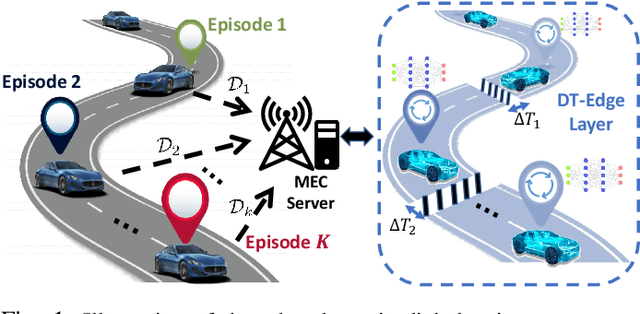
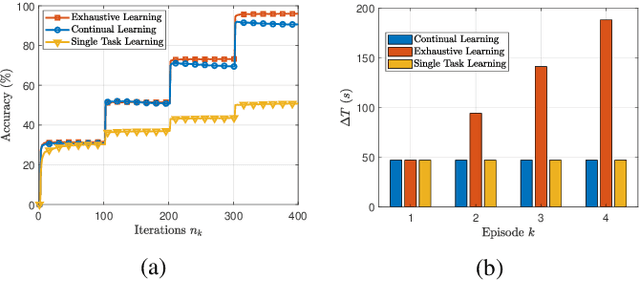
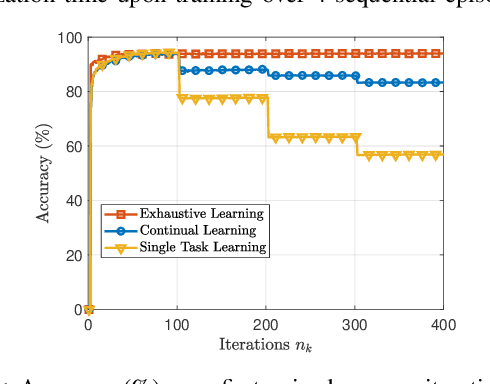
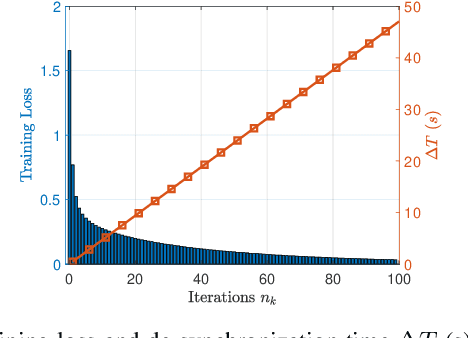
Abstract:Digital twins (DTs) constitute a critical link between the real-world and the metaverse. To guarantee a robust connection between these two worlds, DTs should maintain accurate representations of the physical applications, while preserving synchronization between real and digital entities. In this paper, a novel edge continual learning framework is proposed to accurately model the evolving affinity between a physical twin (PT) and its corresponding cyber twin (CT) while maintaining their utmost synchronization. In particular, a CT is simulated as a deep neural network (DNN) at the wireless network edge to model an autonomous vehicle traversing an episodically dynamic environment. As the vehicular PT updates its driving policy in each episode, the CT is required to concurrently adapt its DNN model to the PT, which gives rise to a de-synchronization gap. Considering the history-aware nature of DTs, the model update process is posed a dual objective optimization problem whose goal is to jointly minimize the loss function over all encountered episodes and the corresponding de-synchronization time. As the de-synchronization time continues to increase over sequential episodes, an elastic weight consolidation (EWC) technique that regularizes the DT history is proposed to limit de-synchronization time. Furthermore, to address the plasticity-stability tradeoff accompanying the progressive growth of the EWC regularization terms, a modified EWC method that considers fair execution between the historical episodes of the DTs is adopted. Ultimately, the proposed framework achieves a simultaneously accurate and synchronous CT model that is robust to catastrophic forgetting. Simulation results show that the proposed solution can achieve an accuracy of 90 % while guaranteeing a minimal desynchronization time.
Reliable Beam Tracking with Dynamic Beamwidth Adaptation in Terahertz (THz) Communications
Jan 17, 2022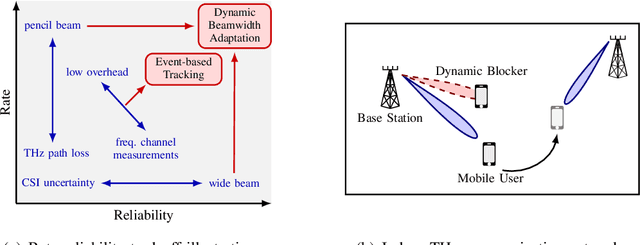
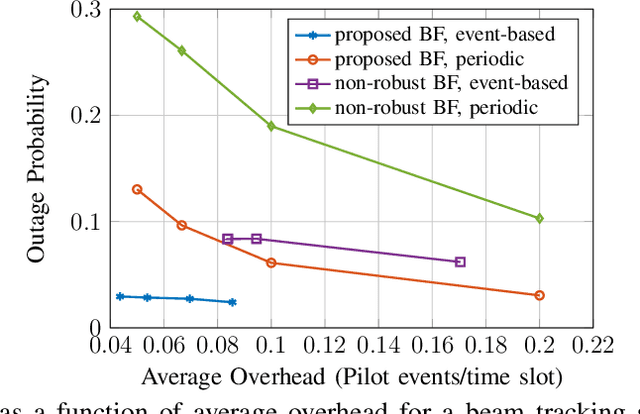
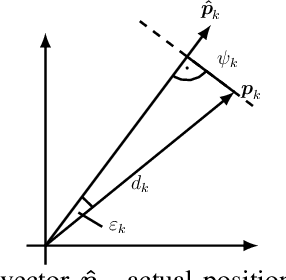
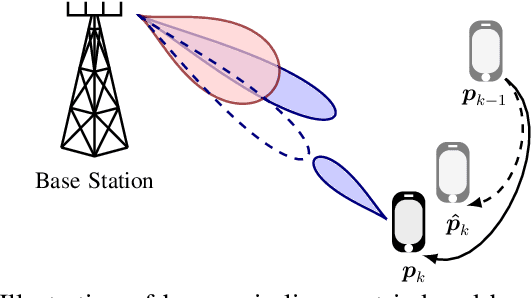
Abstract:THz communication is regarded as one of the potential key enablers for next-generation wireless systems. While THz frequency bands provide abundant bandwidths and extremely high data rates, the operation at THz bands is mandated by short communication ranges and narrow pencil beams, which are highly susceptible to user mobility and beam misalignment as well as channel blockages. This raises the need for novel beam tracking methods that take into account the tradeoff between enhancing the received signal strength by increasing beam directivity, and increasing the coverage probability by widening the beam. To address these challenges, a multi-objective optimization problem is formulated with the goal of jointly maximizing the ergodic rate and minimizing the outage probability subject to transmit power and average overhead constraints. Then, a novel parameterized beamformer with dynamic beamwidth adaptation is proposed. In addition to the precoder, an event-based beam tracking approach is introduced that enables reacting to outages caused by beam misalignment and dynamic blockage while maintaining a low pilot overhead. Simulation results show that our proposed beamforming scheme improves average rate performance and reduces the amount of communication outages caused by beam misalignment. Moreover, the proposed event-triggered channel estimation approach enables low-overhead yet reliable communication.
 Add to Chrome
Add to Chrome Add to Firefox
Add to Firefox Add to Edge
Add to Edge